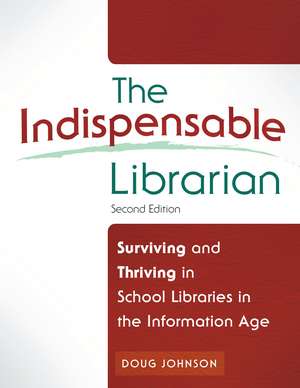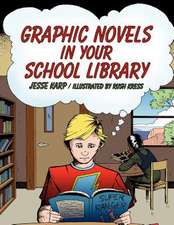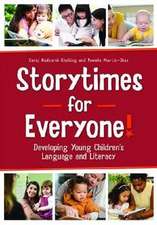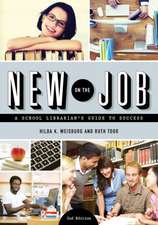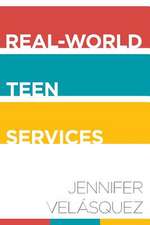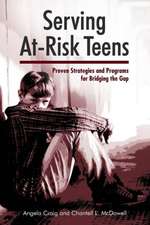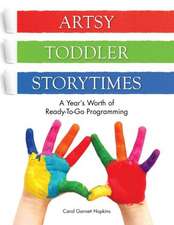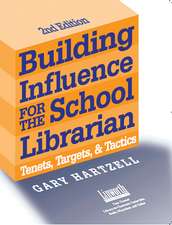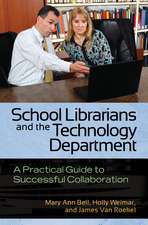The Indispensable Librarian: Surviving and Thriving in School Libraries in the Information Age
Autor Douglas A. Johnsonen Limba Engleză Paperback – 8 mai 2013 – vârsta până la 17 ani
Preț: 243.32 lei
Preț vechi: 341.63 lei
-29% Nou
Puncte Express: 365
Preț estimativ în valută:
46.56€ • 50.56$ • 39.11£
46.56€ • 50.56$ • 39.11£
Carte tipărită la comandă
Livrare economică 22 aprilie-06 mai
Preluare comenzi: 021 569.72.76
Specificații
ISBN-13: 9781610692397
ISBN-10: 161069239X
Pagini: 232
Dimensiuni: 216 x 279 x 15 mm
Greutate: 0.64 kg
Ediția:Revizuită
Editura: Bloomsbury Publishing
Colecția Linworth
Locul publicării:New York, United States
ISBN-10: 161069239X
Pagini: 232
Dimensiuni: 216 x 279 x 15 mm
Greutate: 0.64 kg
Ediția:Revizuită
Editura: Bloomsbury Publishing
Colecția Linworth
Locul publicării:New York, United States
Caracteristici
Highlights the impact of technology on the library program and serves as a straightforward guide to changes needed in the field
Notă biografică
Doug Johnson is director of media and technology for Mankato Area Public Schools in Mankato, MN.
Cuprins
List of FiguresForeword: You Have to Be MadJoyce Kasman ValenzaAcknowledgmentsIntroduction to the Second EditionChapter One: The Roles and Missions of the LibrarianThe Virtual LibrarianWhat are the challenges facing our profession?Seven ways for librarians to remain relevant in a ubiquitous information environment full of NetGen learnersDo school librarians have "enduring values"?Sample professional mission statement and the elevator speechThe Mankato transition: A case studyFor reflection: Why are you in the profession?Chapter Two: Program AssessmentCreating long-term changeHow will you show your program is impacting student achievement?Why assess your program?The formal library assessmentOngoing assessmentsContext and focusA 12-point library program checklist for principalsFor reflection: Linking libraries and reading achievementChapter Three: PlanningCritical elements of a library/technology planThe planning processUsing goal setting to help in professional evaluationsFor reflection: Twenty-plus years of working with advisory groups-what I've learnedChapter Four: Communications and AdvocacyWhat are the components of an effective communications program?Speaking where people are listeningCan a good library program be a marketing tool for your school?What are the basic rules of effective advocacy?For reflection: What is transparency, and why is it critical to the librarian's success?Chapter Five: Managing Others and CollaborationWorking with the library support staffWorking with the technology departmentWorking with the teaching staff: The fundamentals of successful collaborationFor reflection: What is the secret to successful supervision?Chapter Six: Managing Digital ResourcesYou know you are a 21st-century librarian when . . .How has the library's role changed as information and books go digital?What is cloud computing, and how can librarians take advantage of it?For reflection: E-books and librariesChapter Seven: CurriculumPutting technology skills in their placeIntegrating technology skills into an information literacy curriculumBuilding an information/technology literacy curriculumElements of projects that motivateWhat new skills are needed to survive the information jungle?How can librarians support the development of "right brain" skills?For reflection: What does a library for a postliterate society look like?Chapter Eight: BudgetBudgeting as a library ethicTen strategies of effective library budgetersGood purchasing strategiesFor reflection: WeedChapter Nine: FacilitiesWhy should I go to the library when the library will come to me?The fundamentals of good school library design and why they are still importantTen common design pitfalls and how to avoid themFor reflection: Are there schools that don't need a library?Chapter Ten: Digital Intellectual FreedomFreedom to learnMaintaining intellectual freedom in a filtered worldBest practices for meeting CIPA requirementsSeven myths about Internet filtersFor reflection: Getting websites unblockedChapter Eleven: Ethics and TechnologyHow has technology impacted the ethical practice of librarians?Knowing right from wrong in the digital ageFor reflection: Guidelines for educators using social and educational networking sitesChapter Twelve: Copyright and Creative CommonsMake a copyright u-turn and other audacious statements about copyrightCreative Commons and why it should be more commonly understoodFor reflection: Why students (and adults) satisficeChapter Thirteen: The Librarian's Role in Effective Staff DevelopmentThe why, what, and who of staff development in technology and the librarian's roleHow can we provide effective staff development opportunities for our teachers?For reflection: Top 10 ways to increase your technology skills and knowledge (and the secret to being perceived as a technology guru)Chapter Fourteen: Surviving Professional TransitionsPersonal learning networks-Why you can't afford to wait for the next conferenceFinding the timeWhen your job is on the line . . .For reflection: PreventionChapter Fifteen: Libraries and the FutureA mind-set list for librariansMiles's library: A vision for school librariesFor reflection: Prognostications for libraries and schoolsAfterword: A Day of Ordinary Library MiraclesAuthor's NoteIndex
Recenzii
This revised edition is 90 percent new, making it a valuable asset even to those who have dog-eared copies of the first edition.
This is a book that belongs in school library collections for frequent reference-and even more in the hands of administrators whose vision of the possibilities inherent in a school library might just be approaching the twenty-first century.
This is a book that belongs in school library collections for frequent reference-and even more in the hands of administrators whose vision of the possibilities inherent in a school library might just be approaching the twenty-first century.
